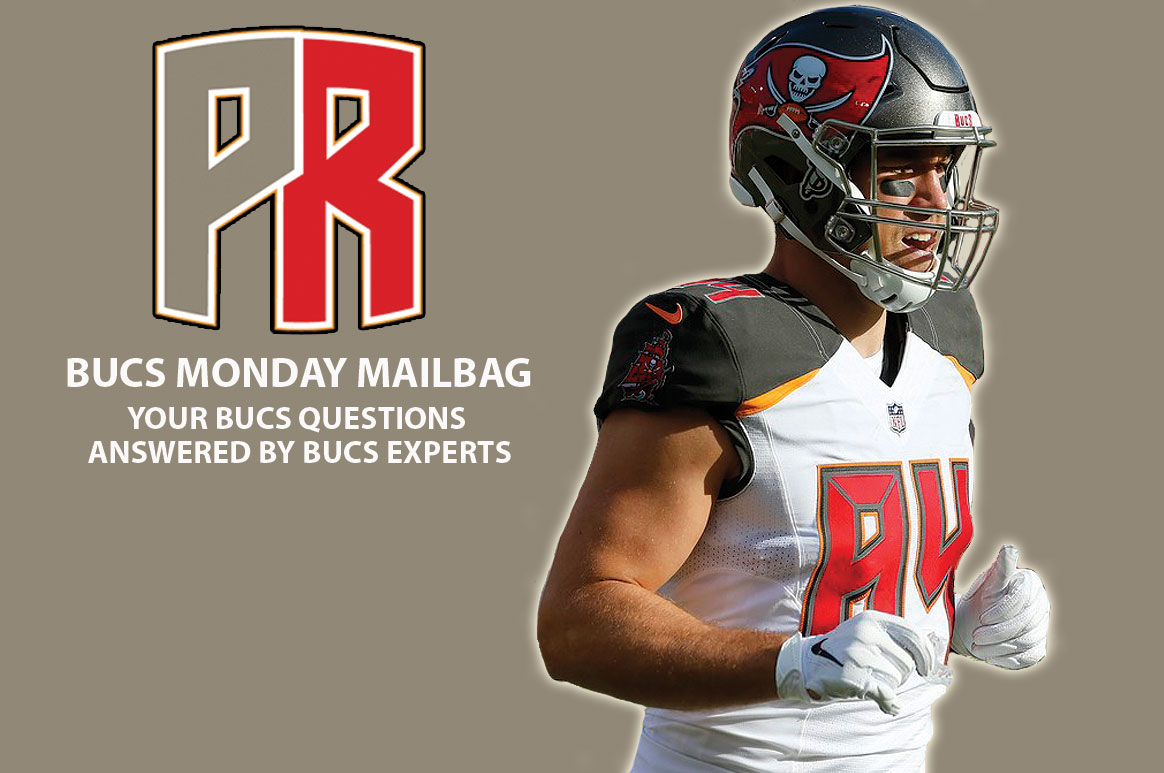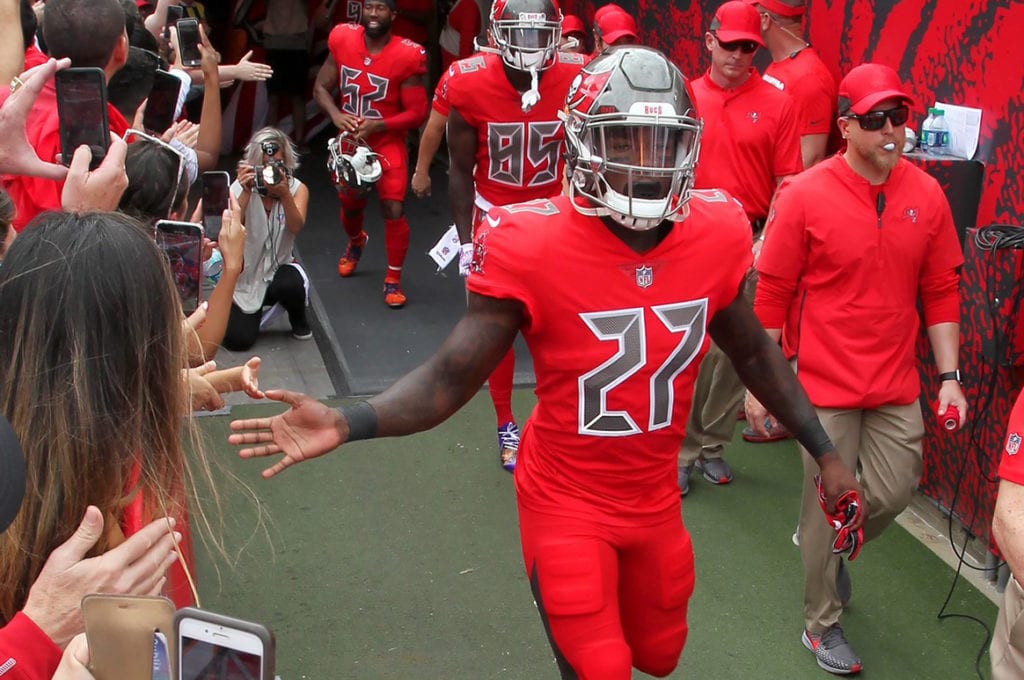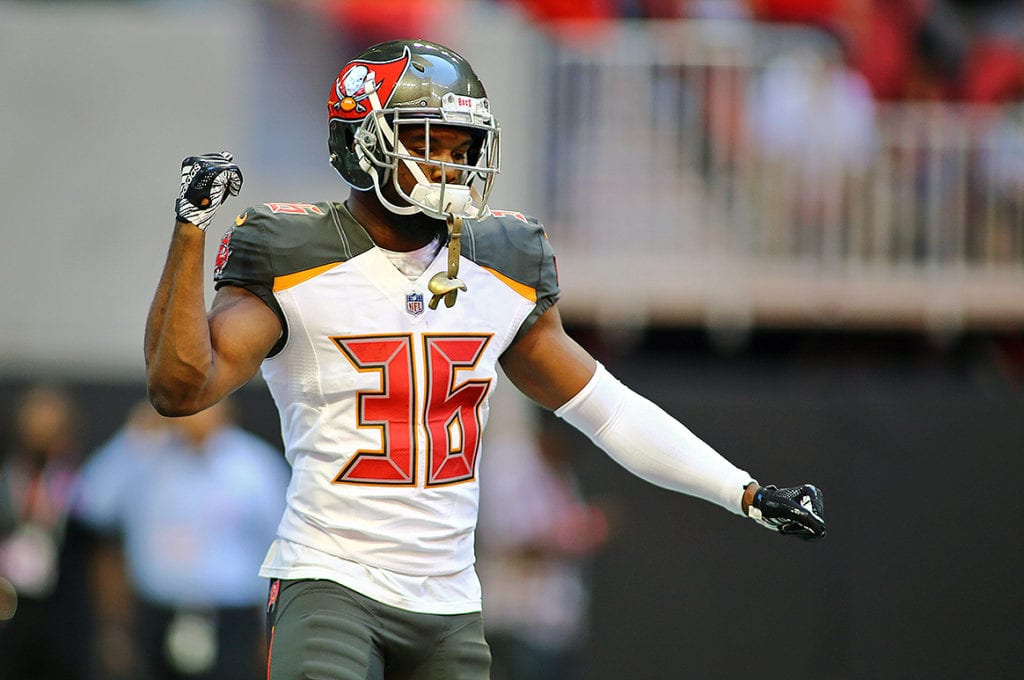The PR Bucs Monday Mailbag is where PewterReport.com’s Mark Cook answers your questions from our Twitter account, but this week the Mailbag will be handled by Taylor Jenkins. You can submit your question each week via Twitter using the hashtag #PRMailbag.
Below are the questions we chose for this week’s edition of the PR Bucs Monday Mailbag.
Question: How big of a role will Cameron Brate have in the Bucs offense with the emergence of O.J. Howard, whom many believe will become a Pro Bowler sooner rather than later? Will there be enough targets for Brate in an offense that has Mike Evans, Chris Godwin, Breshad Perriman and Howard?
Answer: O.J. Howard, Tampa Bay’s first-round pick in 2017, will be the starting tight end for the Bucs this year and there’s a good reason why. Howard is ridiculously talented at 6-foot-6, 255 pounds, and with 4.53 speed, he’s just as fast as Pro Bowl wide receiver Mike Evans. Howard was on his way to a potential Pro Bowl season last year with 34 catches for 565 yards, five touchdowns and an impressive 16.6 yards per catch average before a leg injury caused him to miss the final six games of the season.
Both of Howard’s two seasons in Tampa Bay have ended prematurely due to injury, and in each of those years it’s been Cameron Brate to the rescue. Brate actually wound up with one more target (49 to 48) than Howard did last year, but a nagging hip injury that bothered him all of the 2018 season caused Brate’s average to dip to 9.6 yards per catch as he recorded 30 catches for 289 yards.
Still, Brate remained the red zone threat he’s always been since joining the Bucs, and had six touchdowns on 30 catches, which was the third most scores on the team in 2018. Now that Brate is healthy he is expected to be more productive with the ball in his hands and should produce more yards after the catch.
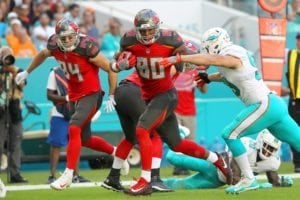
Bucs TEs Cameron Brate and O.J. Howard – Photo by: Cliff Welch/PR
So how many targets can Brate expect to receive in 2019? The hierarchy of targets in Bruce Arians’ offense will be Evans as the top target followed by Chris Godwin, Howard and Breshad Perriman, with Brate and running back Peyton Barber likely battling for the fifth spot on the Bucs’ target totem pole. Barber had 29 targets last year, but wasn’t the team’s third-down back. Instead it was Jacquizz Rodgers, who had 45 targets.
I would suspect that Barber will have close to 45 targets this year as he could be an every down back in Tampa Bay unless someone else emerges in the third-down back role, and that could mean an additional 10 targets for Brate as a backup tight end that would put him around 60. Given Brate’s red zone production and him averaging a touchdown for every five catches, Brate could wind up with 40 catches for 450 yards and seven touchdowns as the team’s No. 2 tight end with Howard having 55 catches for 850 yards and perhaps eight TDs.
Question: We have seen a lot of trade options for the Bucs recently (OLB Jadeveon Clowney, RB Duke Johnson and RB Melvin Gordon) without talking about the salary cap. Which one of these trade options do you think would be the most interesting for the Bucs? And how would the Bucs make it happen with their limited salary cap space?
Answer: While I don’t see any of these players coming to Tampa Bay this season via trade, I think that Cleveland running back Duke Johnson would be both the most interesting and the most plausible.
For Houston outside linebacker Jadeveon Clowney, he would probably be the most impactful addition the Bucs could make out of the three, but with the Texans placing him under the franchise tag he’s owed over $13 million this season. That would likely require the Bucs to release injured outside linebacker Jason Pierre-Paul, freeing $7.5 million in cap space, and then the team would have to free additional space elsewhere as the Bucs have just over $8 million with of cap space and still need to sign inside linebacker Devin White, their first round draft pick. Clowney could fetch a first-round draft pick for Houston, which would be a big price to pay.
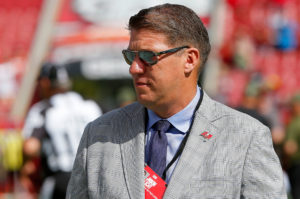
Bucs GM Jason Licht – Photo by: Cliff Welch/PR
Los Angeles running back Melvin Gordon would be an expensive swing for the fences at over $5.6 million this year and it’s unknown what assets the Bucs would need to give up in order to land the talented back. Much like Clowney, Gordon would be a one-year rental as he’s been vocal about getting a new lucrative contract that would be well over $10 million per season. The Bucs coaching staff is also standing behind Peyton Barber, who is in a contract year, and doesn’t seem quite ready to give up on Ronald Jones II, the team’s second-round pick from 2018, quite yet. The Chargers would likely want a premium pick for Gordon, perhaps as high as a second-rounder.
Johnson has made his desire for a trade well-known due to Cleveland’s crowded backfield, and comes in at the cheapest option of the three at $3.05 million this year, and he’s also under contract for the next three years. Johnson has been more productive than any of the Bucs’ current backs, averaging 4.3 yards per carry over his career, and has also developed into one of the league’s most dangerous pass-catching backs. Johnson could possibly be had for a Day 3 pick, which makes him an even more attractive trade option.
David Johnson thrived as a pass-catching weapon under Bruce Arians in Arizona but acquiring Duke Johnson would once again require the Bucs’ staff to feel a big enough need beyond Barber, Jones and the wildcard back that makes it to Tampa Bay’s 53-man roster to justify the contract that comes with him.
Question: Why is outside linebacker Shaq Barrett seemingly an afterthought addition? He was productive in Denver, learned under good coaches, played opposite Von Miller, and is a young player who already knows how to play in a 3-4 scheme.
Answer: I wouldn’t necessarily call Shaquil Barrett an afterthought as much as I would call him a player who’s flying under the radar, and that’s understandable. The Bucs went through widespread changes to the locker room and coaching staff this offseason, and Barrett is largely unproven as a consistent defensive factor, as shown by his one-year prove-it deal at $4 million.

Bucs OLB Shaq Barrett – Photo by: Getty Images
Throughout his time in Denver, Barrett was forced to sit behind stellar edge rushers like Von Miller, Danny Trevathan and Bradley Chubb while still finding a way to produce. He only saw greater than 50 percent of the Broncos’ defensive snaps once in his career, but still managed to rack up 14 sacks, 25 tackles for loss, seven forced fumbles and 35 quarterback hits over the past four seasons.
Those numbers don’t jump off the page, but he only missed three games over the past four years, and his production shows the ability to cause disruption and get after the quarterback despite a previously limited role as a rotational rusher. Now entering a year where he could springboard his play into a big, multi-year contract next offseason, at a position of need for the Bucs, Barrett will likely see an increase in opportunities this season on both third downs and in the team’s base 3-4 defense, especially due to Jason Pierre-Paul’s injury. If his numbers rise with his increase in snaps he won’t remain under the radar for long.
Barrett’s career high is 5.5 sacks, which came in Denver during the 2015 season, and he recorded three last year as a rotational pass rusher. While Carl Nassib figures to be Tampa Bay’s leading sacker this year, some inside One Buccaneer Place are quietly projecting Barrett may surprise and approach 10 sacks to lead the Bucs instead.
Question: Would you say the whole Ronald Jones gaining 15 pounds reaction has gone a little overboard? He still looks like the same build, just more muscle. I don’t think his speed will be affected at all.
Answer: I wouldn’t say that a possible increase in his speed is the most important thing to take away from Ronald Jones’ weight gain. I think the bulking up Jones has done this offseason could make him more durable in preparation for a season where he’ll likely see his rushing opportunities spike compared to his rookie season. The diet and workout routine also shows that he’s a player who is committed to working hard in order to improve, whether that comes to fruition or not.

Bucs RBs Ronald Jones II and Peyton Barber – Photo by: Cliff Welch/PR
With just 44 rushing yards on 23 carries during his rookie season, Jones’ struggles on the field were well-documented. But his work has received praise from his coaches and teammates and the Bucs’ new running backs coach Todd McNair insinuated earlier this offseason that Tampa Bay’s second-round pick from 2018 could have also had some struggles with adapting to life as a professional football player in his first year.
Being drafted at just 20 years old, McNair said that Jones seemed a little young and immature, a little “all over the place,” but was a good kid who was working hard to get better. He also claimed that one of the biggest things the coaching staff had tried to instill in him is a focus on all the little things, the day-to-day process of being a pro.
So when looking at Jones’ weight gain, of course it will help him physically as a football player, but to me, the biggest takeaway is that the team’s young running back is working with a confidence and dedication to improving himself despite stumbling out of the gate.

